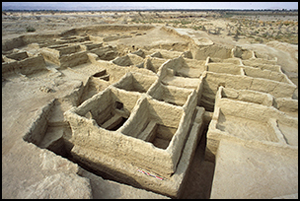Introduction
Growing economic disparity around the world has prompted a renewed interest in the long-term dynamics of inequality (Borgerhoff Mulder et al. Reference Borgerhoff-Mulder2009; Flannery & Marcus Reference Flannery and Marcus2012; Piketty Reference Piketty2014). Archaeology is uniquely placed to investigate these dynamics by offering data and expertise in what constitutes wealth and how institutional mechanisms have shaped inequality over the long term (Chirikure et al. Reference Chirikure2018). There is much to learn from our accumulated data. A previous collaboration (Kohler et al. Reference Kohler2017) revealed surprising continental-scale differences.
GINI (The Global Dynamics of INequalIty Project) brings together archaeologists working across the globe (Figure 1A). Our aim is to investigate the causes and consequences of socioeconomic inequality over prolonged periods across various world regions using metrics of contemporary relevance.

Figure 1. Locations and mean site dates for sites in the GINI Project database as of 16/11/2023. A) all sites; B) boxplots of Ginis for sites with five or more houses by major world region and mean site date (see legend A). Ginis are computed by site on the total area per house, including storage (figure by Tim Kohler).
Project background
It has been argued that human societies have a persistent attraction to inequality (Scheffer et al. Reference Scheffer2017; Chase et al. Reference Chase2020), reflected in the skewed degree distributions of network science, where a few nodes have more links than the rest (Bettencourt Reference Bettencourt2021). Mobile foragers have often been characterised as classless, but some hunter-gatherer-fishers developed marked wealth inequalities, including on a seasonal basis (Wengrow & Graeber Reference Wengrow and Graeber2015; Mattison et al. Reference Mattison2016; Pandit et al. Reference Pandit2020). Wealth inequalities can intensify with the implementation of agriculture, a process apparently amplified by domesticated animals (Kohler et al. Reference Kohler2017; Styring et al. Reference Styring2017). Within a few millennia of agricultural emergence, some societies exhibited enormous wealth and power differences, while others apparently suppressed high inequality and have attracted particular scrutiny by archaeologists (e.g. McIntosh Reference McIntosh2005; Graeber & Wengrow Reference Graeber and Wengrow2021; Green Reference Green2021). Preserved housing evidence, such as the stone house foundations of Hawai‘i Island (Figure 2) and houses and granaries in the Intersalar region, Bolivia (Figure 3), provide key data on past wealth distributions among households.

Figure 2. Aerial view of stone foundations of houses along the coast of Hawai'i Island, Lapakahi State Historical Park (photograph by Mark D. McCoy).

Figure 3. Aerial view of the Loma Pucara site of Ayque (Intersalar Region, Potosi, Bolivia), an altiplanic settlement of the Late Intermediate Period, around AD 1300 (photograph by Pablo Cruz).
Aims of the project
GINI examines Holocene distributions of housing area (i.e. house floor area or size), a continuous variable that has been recorded across archaeological and contemporary datasets. As a proxy for inequality, housing has clear limitations: it constrains our focus to comparisons among residential units and its relationship to inequality may be confounded by other variables. We measure inequality by calculating Gini coefficients over house area distributions and storage capacities within sites and at larger scales of aggregation. We also assess potential biases in sampling, multiproxy indicators of wealth and measures of uncertainty (Fochesato et al. Reference Fochesato, Bogaard and Bowles2019; Fochesato & Bowles Reference Fochesato and Bowles2022; Munson & Scholnick Reference Munson and Scholnick2022).
The project aims to consider global questions and hypotheses about wealth production, distribution and governance. How is resistance to high wealth inequalities achieved (Kohler & Higgins Reference Kohler and Higgins2016; Hodder Reference Hodder2022)? Do societies develop sustained high or low levels of inequality under particular forms of governance (Blanton & Fargher Reference Blanton and Fargher2008)? What is the role of labour- versus land-limited production (Bogaard et al. Reference Bogaard, Fochesato and Bowles2019)? How do the spatial distribution and visibility of housing disparities across settlement systems relate to the persistence of high or low inequality? Addressing such questions requires synthesis of diverse records of housing, ranging from Great Zimbabwe in southern Africa (Figure 4) to Neolithic Mehrgarh in the Indus River basin (Figure 5).

Figure 4. The Great Enclosure (c. AD 1250–1450) at Great Zimbabwe. The drystone walls enclosed courtyards where multiple houses were built (photograph by Shadreck Chirikure).

Figure 5. Neolithic mudbrick houses at Mehrgarh, Indus River basin, Pakistan (photograph by Catherine Jarrige © Mission Archéologique de l'Indus).
We also investigate how house-size distributions reflect wealth inequality today. Large housing datasets and associated economic information (e.g. Leyk et al. Reference Leyk2020) enable assessment of what house sizes represent in contemporary contexts. We assess how far our findings reflect processes common to the past and present.
So far, we have assembled archaeological data on approximately 45 000 houses, ranging in date from more than 20 000 years ago in Western Asia to twentieth-century Melanesia. Preliminary results (Figure 1) show high variability in Gini coefficients, especially in Asia, Europe and Mesoamerica, where data are most abundant. Ongoing analyses seek to disentangle temporal, spatial and ecological trends within and across world regions, including those under-represented in previous work.
GINI pushes beyond categories such as ‘hierarchical’ and ‘egalitarian’ to examine the tensions between these polar modes of social organisation and how inequities are negotiated in particular times and places. If persistent levels of low inequality require fundamental social and economic commitments (e.g. Osborne Reference Osborne2007; Hodder Reference Hodder2022), monitoring long-term archaeological records deserves our closest attention.
Acknowledgements
We thank the Santa Fe Institute for hosting workshop activity for this project. We also thank Dr Aurore Didier for kindly providing access to the photograph of Mehrgarh.
Funding statement
The GINI project is funded by the National Science Foundation (NSF grant no. BCS-2122123) and supported by the Coalition for Archaeological Synthesis (CfAS, http://www.archsynth.org/) and the Center for Collaborative Synthesis in Archaeology (CCSA, https://ibsweb.colorado.edu/archaeology/).







